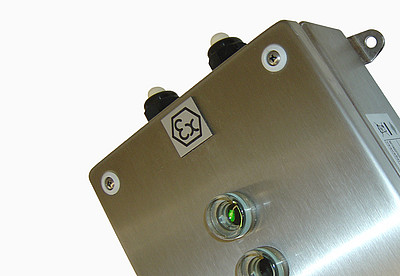Aastra, DeTeWe, ERICSSON, ascom
DECT base station RM 588
The RM 588 Ex G (Gas) radio base station (RBS) allows for the complete integration of DECT radio networks in the IP infrastructure and offers 8 simultaneous calls. Power supply is ensured by a separate power supply unit or by power over Ethernet. This product design offers both indoor and outdoor version in one device. You have the option to use directional or dipole antennas. Thus it is possible to equip even difficult spaces or areas with an ideal radio network. Each base station works flexibly with 12 of the 120 radio channels and guarantees adequate communication capacities.
DECT-Basisstation Typ RFP24ExG
Die Basisstationen bilden die Funkzellen und führen die Kommunikation mit den schnurlosen Systemtelefonen. Sie werden mit 1 bis 2 systemspezifischen UPN-Schnittstellen an den Funkvermittler oder mit 1 UPN-Schnittstelle direkt an der Systemsteuerung angeschlossen. Die Anschalteart ist abhängig von der Systemvariante. Damit können gleichzeitig bis zu 8 Gespräche (bei Anschaltung von 2 UPN) über eine Basisstaion geführt werden. Der optimale Standort der Basisstationen zur Funkabdeckung eines Gebäudes oder des Betriebsgeländes wird durch eine funktechnische Messung bei der Projektierung bestimmt. Für erhöhte Funkreichweiten ist der Einsatz von Spezialantennen (explosionsgeschützte Richtfunkantennen) möglich.
DECT base station BS340-9011/4F1ExG
The Explosion safe base station BS340-9011/4F1ExG is a unit in the Digitally Enhanced Cordless Telephone System (DECT) at the Frequency band between 1880-1900 MHz. The basic function of the base station is the transmission and reception of DECT radio signals. The design and certification are based on the European Directive no. 94/9/EC (ATEX). The base station has two radio modules providing two simultaneous communication channels, for messaging, voice communication and personal alarms from handsets. The connection between the base station and the radio exchange is established via two proprietary Uinterfaces using 2B+D. Each U-interface uses one twisted pair. The two bidirectional U-interfaces provide a data rate of 128 kbits/s for speech each, which is sufficient for 8 simultaneous calls. The maximum length of the cable between the radio exchange and the base station depends on the supply voltage, the wire thickness of the twisted pair cables and the number of express power pairs used. The length of the cable between the radio exchange and base stations can be up to 3.5 km for add-on systems and 1.9 km for MD110 BC10 systems.
DECT locator 9dLD ExG
An integral part of the Ascom 9d System, the 9dLDExG allows stationary staff or crash teams to easily keep track of their mobile colleagues. In the event of an alarm, any colleague or team-mate in distress can be quikkly found and the crisis can be resolved rapidly and efficiently.
The 9d Location Device – whether openly fixed or built-in – transmits a signal that is picked up by the 9d handset. The co-ordinates of the nearest base station and the two latest location codes are automatically transmitted to the monitor via the handset. Instantly processed by the alarm management system, this allows the staff at base to accurately establish both direction and location of their colleague in the case of a personal attack, a fire alarm or an operational disturbance.
Whether fixed to monitor a room, a corridor, a stairwell or an entire building, the 9d Location Device is highly precise. Both the cell size and the setup of the location transmitter are customised to suit the specific needs of the customer, depending on the risk level and the layout of the premises. Furthermore, the 9dLD is designed to interact with previously installed Ascom telePROTECT systems and to coexist with other cordless alarm systems with minimum risk of interference.
Offering the highest accuracy and reliability, the 9dLDExG locator is built on pure DECT. Previously installed Ascom 9d systems can be upgraded with location, with no cabling required. This means that if the security requirements of your operations change, the 9dLD range and set-up can be adjusted to satisfy the new conditions with minimal effort. To make alterations as simple, trouble-free and inexpensive as possible, upgrading is primarily software-oriented.
Technical specifications of the base stations
| Field of application: | Exterior / interior zones |
| Housing finish: | 1.4301 stainless steel with line pattern surface and a circumferential foamed PU sealing |
| Wall thickness: | 1.25 mm continuously |
| Door, number of screw caps: | 1 triangular central locking |
| Wall brackets: | 4 wall brackets at the housing |
| Integrated heating: | 24 V / 24 Watt self-regulating |
| Temperature range: | -40 °C to +45 °C |
| Protection category: | IP 66 |
| Weight: | 4.5 kg |
| Dimensions (LxWxD in mm): | 200 x 200 x 130 |
| Explosion protection: | Ex II 2 G (Gas) |
| Main protection category: | Ex mb e IIC T4 |
| Antenna ducts: | 2 |
| Cable screwing: | 2 x M20 |
| Miscellaneous: | Visual indicator for status monitoring |
Dokumente und Bescheinigungen
- RFP L32 IP Ex G (Gas) (376 kB) operating instructions
- Betriebsanleitung DECT-Basisstation Type RFP24ExG, Art.-Nr.: 40910
- Betriebsanleitung DECT-Basisstation Type RFP24ExG, Art.-Nr.: 40911
- Betriebsanleitung Lokator 9dLD ExG (Gas)
- Betriebsanleitung DECT-Basisstation BS340-9011/4F1ExG (Gas)
- TÜV-Konformitätsbescheinigung für DECT - Basisstation RFP L32 IP Ex G (Gas)
- TÜV-Konformitätsbescheinigung für DECT-Basisstation BS340-9011/4F1ExG (Gas)
- TÜV-Konformitätsbescheinigung für DECT-Lokator 9dLD ExG (Gas)






